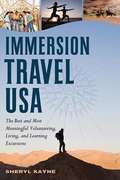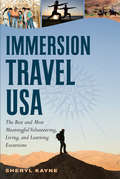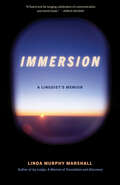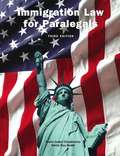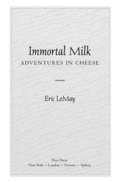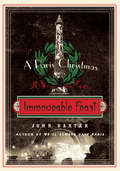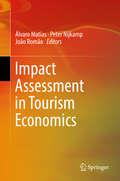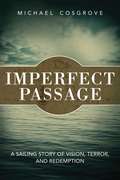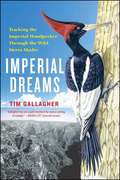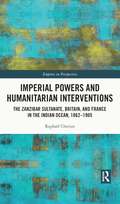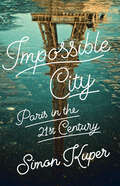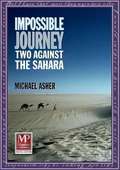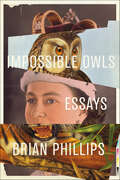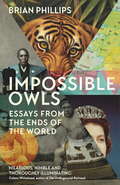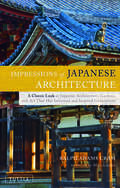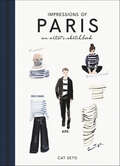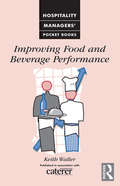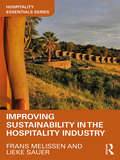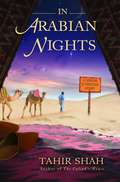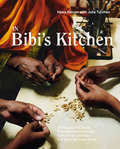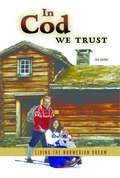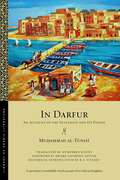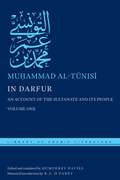- Table View
- List View
Immersion Travel U.S.A.: The Best and Most Meaningful Volunteering, Living, and Learning Excursions
by Sheryl KayneImmersion travel is for everyone at all ages and stages of life. It means taking an active part in where you visit in order to learn about the culture, traditions, and characteristics of each particular place. Designed to be a resource and idea book, this guide provides practical information about immersion travel, special considerations and costs, and how to plan and take vacations, sabbaticals, side trips, and more.
Immersion Travel USA: The Best and Most Meaningful Volunteering, Living, and Learning Excursions
by Sheryl KayneAwarded the 2009 Silver Medal in the Society of American Travel Writers Foundation's annual Lowell Thomas Travel Journalism Competition: the first and only travel book devoted solely to immersion travel—volunteering, living, and learning trips within the United States! This book will absolutely changes lives and the way you think about travel in the United States. Designed to be a resource and idea book, this guide provides practical information about immersion travel; special considerations and costs; how to plan and take vacations, sabbaticals, side trips, and more. There are chapters filled with candid, warm stories from travelers who have been there, done that. It's exciting to visit a national park, but it's a lifetime experience to live inside one for an extended amount of time. Help others and enjoy yourself by biking and building homes across the country. Learn the fine art of making an authentic Windsor chair. Work as a caretaker and live in a lighthouse. Care about returning the wolf to its natural habitat. Play in the High Sierra Mountains backpacking and camping.
Immersion: A Linguist's Memoir
by Linda Murphy MarshallFans of the self-discovering journeys in Cheryl Strayed’s Wild and Andrew McCarthy’s The Longest Way Home will love diving into linguist Linda Murphy Marshall’s adventure-filled international journey as she overcomes her past to find her place in the world—all over the world.Immersion is a memoir that takes the reader on a captivating emotional and physical journey through Linda Murphy Marshall’s life: from the longstanding, crippling impact of family members’ low expectations and abuse, to her discovery as a young adult that she possesses special skills in foreign languages. Linda is taught from an early age that she has little of value to offer the world. But her love of and affinity for languages enables her to create a new life—to separate herself from her toxic environment and to build a successful, decades-long career as a professional multilinguist. It’s a rewarding vocation, but a challenging one: her assignments with the US federal government take her on some hair-raisingly dangerous journeys, some to countries with unstable governments and even active war zones. But these sometimes-harrowing experiences teach her how to open the “windows” around her, unearth her true self, and develop a healthy sense of self-worth—and ultimately, paradoxically, her work and travel so far from home allow her to come home to herself.
Immigration Law for Paralegals (3rd Edition)
by Gloria Roa Bodin Maria Isabel CasablancaImmigration Law for Paralegals is an indispensable and practical guide on U.S. immigration, citizenship and visa procedures for instructing and training students or anyone interested in a career as an immigration paralegal or legal assistant. The new edition has a new chapter on court litigation which also includes writs of mandamus and habeas corpus with federal courts.
Immortal Milk: Adventures in Cheese
by Eric LemayA pithy and picky tour through everything worth knowing about cheese.
Immoveable Feast
by John BaxterA witty cultural and culinary education, Immoveable Feast is the charming, funny, and improbable tale of how a man who was raised on white bread-and didn't speak a word of French-unexpectedly ended up with the sacred duty of preparing the annual Christmas dinner for a venerable Parisian family. Ernest Hemingway called Paris "a moveable feast"-a city ready to embrace you at any time in life. For Los Angeles-based film critic John Baxter, that moment came when he fell in love with a French woman and impulsively moved to Paris to marry her. As a test of his love, his skeptical in-laws charged him with cooking the next Christmas banquet-for eighteen people in their ancestral country home. Baxter's memoir of his yearlong quest takes readers along his misadventures and delicious triumphs as he visits the farthest corners of France in search of the country's best recipes and ingredients. Irresistible and fascinating, Immoveable Feast is a warmhearted tale of good food, romance, family, and the Christmas spirit, Parisian style.
Immoveable Feast
by John BaxterA witty cultural and culinary education, Immoveable Feast is the charming, funny, and improbable tale of how a man who was raised on white bread--and didn't speak a word of French--unexpectedly ended up with the sacred duty of preparing the annual Christmas dinner for a venerable Parisian family.Ernest Hemingway called Paris "a moveable feast"--a city ready to embrace you at any time in life. For Los Angeles-based film critic John Baxter, that moment came when he fell in love with a French woman and impulsively moved to Paris to marry her. As a test of his love, his skeptical in-laws charged him with cooking the next Christmas banquet--for eighteen people in their ancestral country home. Baxter's memoir of his yearlong quest takes readers along his misadventures and delicious triumphs as he visits the farthest corners of France in search of the country's best recipes and ingredients. Irresistible and fascinating, Immoveable Feast is a warmhearted tale of good food, romance, family, and the Christmas spirit, Parisian style.
Impact Assessment in Tourism Economics
by Peter Nijkamp João Romão Álvaro MatiasThis book presents a series of studies on the socio-economic impacts of tourism, with a special focus on the determinants of tourism competitiveness at the destination level. The authors offer a systematic overview of this important issue, presenting relevant empirical studies from different parts of the world, based on modern theoretical approaches and adequate analysis tools, in the context of their policy or managerial implications. The first part of the book discusses the analysis and assessment of quantitative tourism impacts on local economies, while the second part focuses on non-material aspects of tourism development, in particular those related to the role of innovation and human resources. The final section highlights the different dynamics often observed in tourism destinations arising from the interaction between tourists and local communities.
Imperfect Passage
by Michael CosgroveMichael Cosgrove had a beautiful family, a successful career, and a lovely Southern California home overlooking the Pacific Ocean. At the age sixty, he decided to leave that all behind to sail around the world. In spite of his romanticized vision of rugged individualism and salty tales to share with his grandchildren, Cosgrove quickly realizes that sailing around the world isn't going to be as easy as he'd imagined. From a psychotic crewmate, sleep deprivation, and mental breakdowns, to stormy weather and hallucinations, Cosgrove rides the waves, holding on as best he can to his dream of "doing something grand." Alone, and thousands of miles away from everyone and everything he loves, he is forced to ask himself one question: what in God's name am I doing here? In his attempt to avoid the inevitable (growing old, weak, frail), Cosgrove runs amok. He breaks his budget to outfit the boat and then refuses to read the manuals. He enters unfamiliar harbors in the dead of night, hires a violent first mate, and sails headlong into ferocious storms. In the midst of his adventures, he longs for the simpler days when his four daughters were still children, when his first marriage was still intact, and when his future still seemed bright and expansive. Though driven by scenes of sheer terror, absurd folly, and deep inner searching, Cosgrove keeps his sense of humor throughout his harrowing journey. Imperfect Passage is the story of one man's perseverance against Father Time and Mother Nature, proving that with enough will, one can, in his or her own way, conquer the unconquerable. Michael Cosgrove will be donating a portion of his profits to the Navy Special Warfare Family Foundation.
Imperfect Passage: A Sailing Story of Vision, Terror, and Redemption
by Michael CosgroveTurning sixty isn’t the end; it’s only the beginning. Michael Cosgrove had a beautiful family, a successful career, and a lovely Southern California home overlooking the Pacific Ocean. At age sixty, he decided to leave all that behind to sail around the world. With the vision of rugged individualism and salty tales to share with his grandchildren, Cosgrove quickly realized that sailing around the world wasn’t as easy as he had imagined. From a psychotic crewmate, to sleep deprivation and mental breakdowns, to constant storms and hallucinations, Cosgrove rode the waves, trying to keep his idea of "doing something grand” alive. Alone, and thousands of miles away from everyone he loved, he was forced to ask himself one question: What in God’s name am I doing here? In his attempt to avoid the inevitable (growing old, weak, frail), Cosgrove runs amok. He breaks his budget to outfit the boat and then refuses to read the manuals. He enters unfamiliar harbors in the dead of night, hires a violent first mate, and sails headlong into ferocious storms. At the same time, he longs for the simpler days when his four daughters were still children, when his first marriage was still intact, and when his dreams were still within reach. Though driven by scenes of sheer terror, absurd folly, and deep inner searching, the tone is always buoyant and laugh-out-loud funny. Imperfect Passage is the story of one man’s perseverance against Father Time and Mother Nature, proving that with enough will, one can indeed conquer the unconquerable.
Imperial Dreams: Tracking the Imperial Woodpecker Through the Wild Sierra Madre
by Tim GallagherA decade ago, Tim Gallagher was one of the rediscoverers of the legendary ivory-billed woodpecker, which most scientists believed had been extinct for more than half a century—now Gallagher once again hits the trail, journeying deep into Mexico&’s savagely beautiful Sierra Madre Occidental, home to rich wildlife, as well as to Mexican drug cartels, in a perilous quest to locate the most elusive bird in the world—the imperial woodpecker.The imperial woodpecker&’s trumpetlike calls and distinctive hammering on massive pines once echoed through the high forests. Two feet tall, with deep black plumage, a brilliant snow-white shield on its back, and a crimson crest, the imperial woodpecker had largely disappeared fifty years ago, though reports persist of the bird still flying through remote mountain stands. In an attempt to find and protect the imperial woodpecker in its last habitat, Gallagher is guided by a map of sightings of this natural treasure of the Sierra Madre, bestowed on him by a friend on his deathbed. Charged with continuing the quest of a line of distinguished naturalists, including the great Aldo Leopold, Gallagher treks through this mysterious, historically untamed and untamable territory. Here, where an ancient petroglyph of the imperial can still be found, Geronimo led Apaches in their last stand, William Randolph Hearst held a storied million-acre ranch, and Pancho Villa once roamed, today ruthless drug lords terrorize residents and steal and strip the land. Gallagher&’s passionate quest takes a harrowing turn as he encounters armed drug traffickers, burning houses, and fleeing villagers. His mission becomes a life-and-death drama that will keep armchair adventurers enthralled as he chases truth in the most dangerous of habitats.
Imperial Powers and Humanitarian Interventions: The Zanzibar Sultanate, Britain, and France in the Indian Ocean, 1862–1905 (Empires in Perspective)
by Raphaël CheriauIn the second half of the nineteenth century, the Zanzibar Sultanate became the focal point of European imperial and humanitarian policies, most notably Britain, France, and Germany. In fact, the Sultanate was one of the few places in the world where humanitarianism and imperialism met in the most obvious fashion. This crucial encounter was perfectly embodied by the iconic meeting of Dr. Livingstone and Henry Morton Stanley in 1871. This book challenges the common presumption that those humanitarian concerns only served to conceal vile colonial interests. It brings the repression of the East African slave trade at sea and the expansion of empires into a new light in comparing French and British archives for the first time.
Impossible City: Paris in the Twenty-First Century
by Simon KuperAn entertaining and openhearted tale of a naïf eventually getting to understand a complex, glittering, beautiful and often cruel society - at least a little. When Simon Kuper left London for Paris in his early thirties, he wasn't planning to make a permanent move. Paris, however, had other plans. Kuper has grown middle-aged there, eaten the croissants, seen his American wife through life-threatening cancer, taken his children to countless football matches on freezing Saturday mornings in the city's notorious banlieues, and in 2015 lived through two terrorist attacks on their neighborhood. Over two decades of becoming something of a cantankerous Parisian himself, Kuper has watched the city change. This century, it has globalized, gentrified, and been shocked into realizing its role as the crucible of civilizational conflict. Sometimes it's a multicultural paradise, and sometimes it isn't. This decade, Parisians have lived through a sequence of shocks: terrorist attacks, record floods and heatwaves, the burning of Notre Dame, the storming of the city by gilets jaunes, and then the pandemic. Now, as the Olympics come to town, France is busy executing the "Grand Paris" project: the most serious attempt yet to knit together the bejewelled city with its neglected suburbs. This is a captivating memoir of the Paris of today, without the Parisian clichés.
Impossible Journey: Two Against the Sahara
by Michael AsherWritten by the same author as "A Desert Dies" and "In Search of the Forty Days Road", this book describes the longest camel journey ever made by Westerners. The author and his wife made unique observations along the way of the effects of the drought and the increasing spread of the desert.
Impossible Owls: Essays
by Brian PhillipsThe acclaimed journalist’s New York Times–bestselling essay collection: “hilarious, nimble, and thoroughly illuminating” (Colson Whitehead, author of The Underground Railroad).In this highly anticipated debut collection, Brian Phillips demonstrates why he’s one of the most iconoclastic journalists of the digital age, beloved for his ambitious, off-kilter, meticulously reported essays that read like novels.The eight essays assembled here—five from Phillips’s Grantland and MTV days, and three new pieces—go beyond simply chronicling some of the modern world’s most uncanny, unbelievable, and spectacular oddities. They explore the interconnectedness of the globalized world, the consequences of history, the power of myth, and the ways people attempt to find meaning.Phillips searches for tigers in India, and uncovers a multigenerational mystery involving an oil tycoon and his niece turned stepdaughter turned wife in the Oklahoma town where he grew up. Dogged and self-aware, Phillips is an exhilarating guide to the confusion and wonder of the world today. If John Jeremiah Sullivan’s Pulphead was the last great collection of New Journalism from the print era, Impossible Owls is the first of the digital age.
Impossible Owls: Essays from the Ends of the World
by Brian PhillipsNEW YORK TIMES BESTSELLER'Hilarious, nimble, and thoroughly illuminating' Colson Whitehead, author of The Underground Railroad'Recalls the work of John Jeremiah Sullivan and the late David Foster Wallace, with a dash of Janet Malcolm' VogueFrom its opening journey into remote Alaska for the Iditarod Sled Dog Race, IMPOSSIBLE OWLS leads us on a kaleidoscopic exploration of contemporary reality. Brian Phillips takes us to a sumo tournament in Japan, the jungle in India, the studio of a great Russian animator, a royal tour of the Yukon Territory with the Duke and Duchess of Cambridge and into the weird heart of America. This exhilarating debut visits borders both real and imagined, and asks what it means, in our age, to travel to the end of the map.
Impressions of Japanese Architecture
by Mira Locher Ralph Adams Cram"The best book on Japanese architecture ever produced by a Westerner." --The American ArchitectJapanese architecture is undoubtedly less well known and less appreciated than the architecture of any other civilized nation. Not only this, but it is almost universally misjudged, and while the world has by degrees come to know and admire the pictorial and industrial arts of Japan, her architecture, which is the rot and vehicle of all other modes of art, is passed over with a casual reference to its fantastic quality or a patronizing tribute to the excellence of some of its carved decoration.Written at a time when Japanese art was only beginning to be appreciated in the West, Impressions of Japanese Architecture conveys a sense of discovery and enthusiasm that modern readers will find as interesting and infectious as the book's first readers did. Long considered a classic, this new edition contains a foreword by acclaimed contemporary architect and author, Mira Locher. Originally published about one hundred years ago, Impressions of Japanese Architecture is still of immense value to anyone wishing for a better understanding of Japanese architecture, art and culture.
Impressions of Paris: An Artist's Sketchbook
by Cat SetoArtist Cat Seto, founder of the acclaimed Ferme à Papier brand, introduces you to the City of Light as never before in this distinctive volume—both a visual feast and celebration of the artistic process—filled with lavish illustrations and descriptive meditations that capture the quotidian pleasures of France’s capital city and how they have inspired creativity.In Impressions of Paris, Cat Seto takes you on a dazzling and enlightening tour of Paris, from familiar sights to hidden surprises, to reveal this legendary city as never before. Combining informative and entertaining vignettes, stories, and notes with stunning full-color illustrations, she draws parallels between the city and the art it inspires. Organized around four main principles of art—color, pattern, perspective, and rhythm—Impressions of Paris is a celebration of the artistic spark in the city’s mundane yet marvelous details: the pistachio and cassis palette triggered by the ice cream case at Berthillon; how a rainy stroll through an open air market transforms into a smudgy gouache (pronounced gwash) pattern; the lovely ubiquity of the iconic French stripe, the Breton.Pretty and inventive, surprising and stimulating, Impressions of Paris captures the beauty and charms of this stunning city and extols its power to stimulate the creative imagination—inviting artists and art appreciators to intimately experience a painter’s process.
Improving Food and Beverage Performance
by Keith WallerThe food and beverage aspect of hotel operations is often the most difficult area to control effectively, but it plays a crucial role in customer satisfaction. Improving Food and Beverage Performance is able to show how successful catering operations can increase profitability whilst providing continuing improvements in quality, value and service. Keith Waller looks at the practical issues of improving performance combining the key themes of quality customer service and efficient management. This text will enable managers and students alike to recognise all the contributing factors to a successful food and beverage operation.Keith Waller is Senior Lecturer for the Faculty of Business and Management at Blackpool and the Fylde College. He has extensive experience in the hospitality industry and is a member of the Hotel and Catering International Management Association. He is the co-author, with Professor John Fuller, of The Menu, Food and Profit.
Improving Sustainability in the Hospitality Industry (Hospitality Essentials Series)
by Frans Melissen Lieke SauerOver the past few years the hospitality industry has become a lot more sustainable than it used to be. However, the industry’s contribution to the sustainable development of our societies is still significantly smaller than it could be. This book specifically addresses the links between operations, tactics and strategy from a sustainable development perspective and moves beyond describing what is to reflect on what could be or even what should be, thus providing students with a concise guide for improving sustainability concepts and businesses in the hospitality industry. Each chapter uses specific cases and examples to reflect on different ways in which sustainability principles can be used for revisiting the host–guest relationship and improving the industry’s business processes and models. In doing so, the book provides current and future professionals with guidelines, inspiration and a call for action to take sustainability within the hospitality industry to the next level, based on inclusiveness, equality and a sustainable relationship with our natural environment.
In Arabian Nights
by Tahir ShahShortly after the 2005 London bombings, Tahir Shah was thrown into a Pakistani prison on suspicion of spying for Al-Qaeda. What sustained him during his terrifying, weeks-long ordeal were the stories his father told him as a child in Morocco. Inspired by this, on his return to his adopted homeland he embarked on an adventure worthy of the mythical Arabian Nights, going in search of the stories and storytellers that have nourished this most alluring of countries for centuries. Wandering through the med...
In Bibi's Kitchen: The Recipes and Stories of Grandmothers from the Eight African Countries that Touch the Indian Ocean [A Cookbook]
by Julia Turshen Hawa HassanGrandmothers from eight eastern African countries welcome you into their kitchens to share flavorful recipes and stories of family, love, and tradition in this transporting cookbook-meets-travelogue.&“Their food is alive with the flavors of mangoes, cinnamon, dates, and plantains and rich with the history of the continent that had been a culinary unknown for much too long.&”—Jessica B. Harris, food historian, journalist, and public speakerIn this incredible volume, Somali chef Hawa Hassan and renowned food writer Julia Turshen present 75 recipes and stories gathered from bibis (or grandmothers) from eight African nations: South Africa, Mozambique, Madagascar, Comoros, Tanzania, Kenya, Somalia, and Eritrea. Most notably, these eight countries are at the backbone of the spice trade, many of them exporters of things like pepper and vanilla. We meet women such as Ma Shara, who helps tourists &“see the real Zanzibar&” by teaching them how to make her famous Ajemi Bread with Carrots and Green Pepper; Ma Vicky, who now lives in suburban New York and makes Matoke (Stewed Plantains with Beans and Beef) to bring the flavor of Tanzania to her American home; and Ma Gehennet from Eritrea who shares her recipes for Kicha (Eritrean Flatbread) and Shiro (Ground Chickpea Stew).Through Hawa&’s writing—and her own personal story—the women, and the stories behind the recipes, come to life. With evocative photography shot on location by Khadija Farah, and food photography by Jennifer May, In Bibi's Kitchen uses food to teach us all about families, war, loss, migration, refuge, and sanctuary.
In Cod We Trust: Living the Norwegian Dream
by Eric DregniEric Dregni&’s great-grandfather Ellef fled Norway in 1893 when it was the poorest country in Europe. More than one hundred years later, his great-grandson traveled back to find that—mostly due to oil and natural gas discoveries—it is now the richest. The circumstances of his return were serendipitous, as the notice that Dregni won a Fulbright Fellowship to go there arrived the same week as the knowledge that his wife Katy was pregnant. Braving a birth abroad and benefiting from a remarkably generous health care system, the Dregnis&’ family came full circle when their son Eilif was born in Norway. In this cross-cultural memoir, Dregni tells the hair-raising, hilarious, and sometimes poignant stories of his family&’s yearlong Norwegian experiment. Among the exploits he details are staying warm in a remote grass-roofed hytte (hut), surviving a dinner of rakfisk (fermented fish) thanks to 80-proof aquavit, and identifying his great-grandfather&’s house in the Lusterfjord only to find out it had been crushed by a boulder and then swept away by a river. To subsist on a student stipend, he rides the meat bus to Sweden for cheap salami with a busload of knitting pensioners. A week later, he and his wife travel to the Lofoten Islands and gnaw on klippefisk (dried cod) while cats follow them through the streets. Dregni&’s Scandinavian roots do little to prepare him and his family for the year in Trondheim eating herring cakes, obeying the conformist Janteloven (Jante&’s law), and enduring the mørketid (dark time). In Cod We Trust is one Minnesota family&’s spirited excursion into Scandinavian life. The land of the midnight sun is far stranger than they previously thought, and their encounters show that there is much we can learn from its unique and surprising culture.
In Darfur: An Account of the Sultanate and Its People (Library of Arabic Literature #70)
by Muḥammad al-TūnisīA merchant’s remarkable travel account of an African kingdomMuḥammad al-Tūnisī (d. 1274/1857) belonged to a family of Tunisian merchants trading with Egypt and what is now Sudan. Al-Tūnisī was raised in Cairo and a graduate of al-Azhar. In 1803, at the age of fourteen, al-Tūnisī set off for the Sultanate of Darfur, where his father had decamped ten years earlier. He followed the Forty Days Road, was reunited with his father, and eventually took over the management of the considerable estates granted to his father by the sultan of Darfur.In Darfur is al-Tūnisī’s remarkable account of his ten-year sojourn in this independent state, featuring descriptions of the geography of the region, the customs of Darfur’s petty kings, court life and the clothing of its rulers, marriage customs, eunuchs, illnesses, food, hunting, animals, currencies, plants, magic, divination, and dances. In Darfur combines literature, history, ethnography, linguistics, and travel adventure, and most unusually for its time, includes fifty-two illustrations, all drawn by the author.In Darfur is a rare example of an Arab description of an African society on the eve of Western colonization and vividly evokes a world in which travel was untrammeled by bureaucracy, borders were fluid, and startling coincidences appear almost mundane.An English-only edition.
In Darfur: An Account of the Sultanate and Its People, Volume One (Library of Arabic Literature #12)
by Muḥammad al-TūnisīA merchant’s account of his travels through an independent African state Muhammad ibn 'Umar al-Tunisi (d. 1274/1857) belonged to a family of Tunisian merchants trading with Egypt and what is now Sudan. Al-Tunisi was raised in Cairo and a graduate of al-Azhar. In 1803, at the age of fourteen, al-Tunisi set off for the Sultanate of Darfur, where his father had decamped ten years earlier. He followed the Forty Days Road, was reunited with his father, and eventually took over the management of the considerable estates granted to his father by the sultan of Darfur. In Darfur is al-Tunisi’s remarkable account of his ten-year sojourn in this independent state. In Volume One, al-Tunisi relates the history of his much-traveled family, his journey from Egypt to Darfur, and the reign of the noted sultan 'Abd al-Rahman al-Rashid. In Darfur combines literature, history, ethnography, linguistics, and travel adventure, and most unusually for its time, includes fifty-two illustrations, all drawn by the author. In Darfur is a rare example of an Arab description of Africa on the eve of Western colonization and vividly evokes a world in which travel was untrammeled by bureaucracy, borders were fluid, and startling coincidences appear almost mundane.A bilingual Arabic-English edition.
